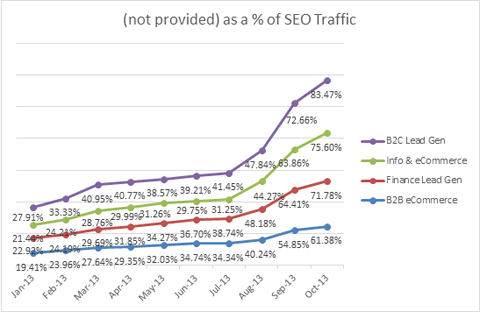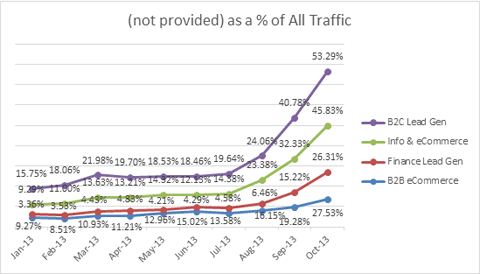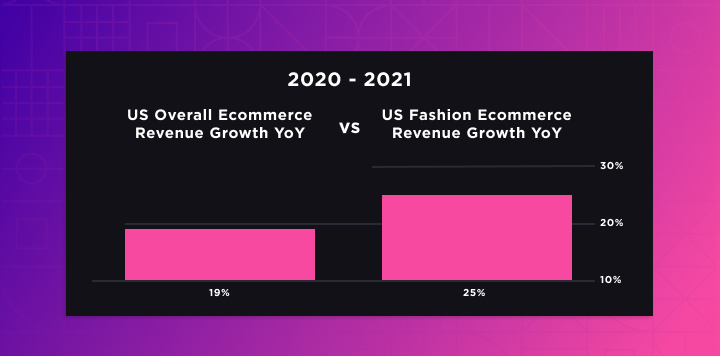So we all know that Google is encrypting organic search data and pulling pretty much all SEO keywords under the (not provided) mask. There has been a lot of pontificating about the why and the perceived impact. I take a much more practical approach to these things so my question is “now what”?
Whether we like it or not this change is here to stay so how can marketing professionals interpret the data available in order to make informed business decisions?

You may feel like you are suddenly making blind decisions, but that is not the case! There is still a lot of data available to you, it is simply a case of knowing what to look for and where to look. First I am going to have a quick look at the situation as it stands:
The Impact of (not provided)
I won’t say I was the first to notice this trend, but I have been monitoring it since mid-September after seeing big increases in (not provided) traffic as a proportion of SEO traffic for several of my clients.
You can see the trends below across 4 very different types of websites:

What is slightly more alarming is the proportion of All Traffic that is now dominated by (not provided), for some websites:

So over 60% of SEO keyword data is no longer available to marketers and in some cases that accounts for around 50% of all traffic sources to the website. That could seem pretty crippling to your digital strategy and reporting.
Alternative Data Sources
So, what are those alternative data sources that we can use? Are they as valuable as the keyword visit and conversion data we have been used to? I have looked at a couple of options, the first of which is an attempted work-around by looking at keyword data from another source: Google Webmaster Tools. The second requires a slightly different approach to data analysis, but hopefully I can convince you that this is the better option.
Can Google Webmaster Tools Give Me the Keyword Data?
I have been working closely with a client to look at the best ways of finding keyword visit data by other means. I have generally disregarded Google Webmaster Tools search query data as it has always been wildly different from the keyword visits data provided by Google Analytics. BUT, desperate times and all that! I recommend reading Ben Goodsell’s very insightful blog post on how to get the most out of the Google Webmaster Tools Search Query data. He outlines the possible pitfalls and gives some top tips on how to interpret the numbers to get the best insight into your campaign.
Important Note on Google Webmaster Tools Search Query Data
In its help section Google says:
“Webmaster Tools aggregates query information. Once the count of each query reaches a certain threshold, it will appear on the Search Queries page. To protect user privacy, Google doesn’t aggregate all data. For example, we may not track some queries that are made a very small number of times.”
So do not think that just because a keyword is not included in the Search Queries it is not driving traffic. The Search Query report also only pulls in the top 2000 search queries, so for sites that have a lot of potential keywords driving traffic many keywords will not be included.
Google also, quite loosely in my opinion, says that the Search Queries report “provides information about Google Web Search queries that have returned pages from your site”. It does not specify if this is only organic search queries or is BOTH paid and organic search queries. If it includes paid search data then this will obviously skew organic keyword reporting via this method. Also note that it only reports on Google web search queries, so keyword visits from other search engines are not accounted for.
Update: This Google blog post states that “the Search Queries report available in Google Webmaster Tools provides aggregate information about the top 2000 queries, each day, that generated organic clicks” so I can confirm that this only shows organic search queries.
SEO Landing Pages
If you have a well-structured keyword and onsite optimisation SEO strategy then you can legitimately make educated assumptions on keyword performance. If each page on your site is well optimised for a specific set of keywords then you can ascertain the keyword performance in the organic search results based on how many landing page visits the page that is optimised for that keyword gets and make decisions accordingly.
For example, in September a page on your site had a lot of organic landing page visits but in October this dropped considerably, as both a number and proportion of all organic landing page visits. You can assume that, all other things being equal (e.g. it not being a seasonality factor), you need to put some focus on enhancing and promoting that page and the keywords it is optimised for.
SEO landing page data can provide a great deal more insight into the performance of your website and search engine optimisation campaign than focusing on keywords. Why? If the pages perform then the rankings and traffic will follow.
Remember Google Panda?
The Google Panda update may feel like old-news but the algorithm changes made back in 2011 are still valid and are influential ranking factors today. A big change that Google made when launching this update was incorporating elements of the user experience of a website into determining its quality. Bounce rate, page load speed, conversion rate, time on site all became ranking factors. So if pages on your site are not performing well on those counts then they will not rank highly.
Now What? It’s All About The User Experience
I have to say that my initial reaction to this change was a mixture of rage and despair, however on further reflection and investigation I have decided to applaud this change.
Google has always been about creating the best possible experience for the user. By not giving us the keyword data Google is forcing marketers to stop focusing on keywords and to put more focus on user experience and ultimately the customer.
This will create a better long term search engine optimisation strategy and will increase your website’s conversion rate and profitability. Everyone’s a winner!

Now, take a look at your website. Forget that you are the marketing person who has put blood, sweat and tears into it. Forget the conversion rate, the traffic sources and the databases that make it work. Become your typical customer. Experience your website from your customers’ perspectives. Be brutally honest with yourself about the good and bad things on the site. Then compare this to the onsite engagement data in Google Analytics.
If an organic landing page has a high bounce rate and you know, from having just been on it, that the amazingly designed banner image takes 4 seconds to load then you have got a very easy fix. Optimising the image for web will result in a better user experience and as a consequence better search engine rankings for relevant keywords, so more traffic and sales. You cannot run a website based solely on your perception of it or solely on data. Marrying the two will give you a rounded view of your website and enable you to make informed, practical decisions on what you need to do in your digital marketing activity.
High search engine rankings should be the by-product of a well-built website, the main outcome being excellent user engagement with the site and lots of conversions.
Good luck transcending keywords!
Follow my contributions to the blog to find out more about digital content marketing, or sign up to the ThoughtShift Guest List, our monthly email, to keep up-to-date on all our blog posts, guides and events.






